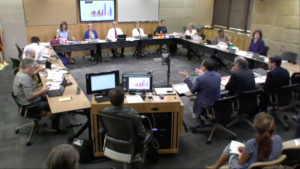“It’s better.” “It still needs work.” Both of those comments came from Austin Mayor Steve Adler as he described the second draft of CodeNEXT in a news conference on Friday, September 15th, hours after the revised code and maps were released to the public. “I think that anyone looking at this new map and this new code if they were honest would have to readily see that the staff has listened and has acted on the community response,” said Adler.
CodeNEXT is the process of revising the city’s Land Development Code to achieve the priorities outlined in Imagine Austin. It’s a process that is headed into its fifth year. Mayor Adler praised what he called an “unprecedented” number of comments residents submitted about the initial draft of CodeNEXT and its maps. However, he also warned that if the public does not remain engaged, or if large groups try to kill the process the city will revert back to the “evils of the status quo.” Among those “evils” are badly managed growth, horrible traffic tie-ups, economic segregation, more housing inflation, more flooding woes, the loss of more people of color and creatives and Austin children not being able to afford to live in the city they grew up in when they become adults.
On Wednesday, September 2o, the full City Council viewed a presentation from City staff and the CodeNEXT consultants. They then had an opportunity to address concerns they had about the draft document. According to Community Impact Newspaper there were six major takeaways from that presentation.
1. CodeNEXT Draft 2.0 increases the city’s housing capacity from 137,830 units to 160,687 units. A large portion of that increase, according to the consultants, results from the new draft’s allowance of residential units in zones that previously allowed only commercial uses. The capacity is calculated by assuming that each parcel of land is built out to its maximum entitlement.
2. Consultants forecast that 10,719 existing units would be subject to redevelopment under the second draft in order to reach the max 160,687 housing capacity. This is an increase from estimates of 10,483 units in the first draft and 7,038 in the existing zoning.
3. District 1 is predicted to carry 20 percent of the new housing capacity, or 32,231 units. District 8 is expected to carry the second most at 12 percent, or 19,481 units. Districts 4, 6, 7 and 10 combine for 23 percent of the new capacity, or 36,568 units.
4. Of the new units, just over 30,000 will be available for families between 50 percent and 80 percent of the area’s median family income, which, according to 2015 estimates, is $73,928. Just over 70,000 units are projected to be available for families between 80 percent and 120 percent MFI, and just over 60,000 will be available for families at over 120 percent MFI.
5. CodeNEXT sub-consultant Fregonese & Associates estimates that 139,571 units will be within a quarter-mile of future and existing bus transit lines.
6. Staff is working to provide numbers on how many affordable units can be expected after the city overhauled its density-bonus programs and how many of those units would be located in each council district.
Council member Ora Houston expressed concern that 20 percent of the new housing capacity would take place in District 1, which she represents. Apparently concerned about more gentrification in East Austin she asked consultants to define how much of that growth will be due to redevelopment in East Austin and how much will come from the development of vacant land in northeast Austin.
Council member Greg Casar said he was impressed that CodeNEXT 2.o forecast an additional 22,000 potential residential properties over the first draft. However he was concerned that not enough affordable housing would be located in so-called “high opportunity” areas where more jobs and retail options exist. Casar called for more income-restricted units in high-opportunity areas.
Council member Delia Garza said she’s hoping there won’t be any new restrictions placed on the size of Accessory Dwelling Units or ADU’s.
Council member Leslie Pool had some environmental concerns, including whether there would be adequate modeling to determine whether new developments might cause flooding.
The City will produce a third draft of CodeNEXT before the new code heads to committees and Council for approval, which is expected to take place in early 2018. The public has until October 31st to submit comments about the code and maps online or at a series of open houses. Learn more about how to get involved on the CodeNEXT webpage.

